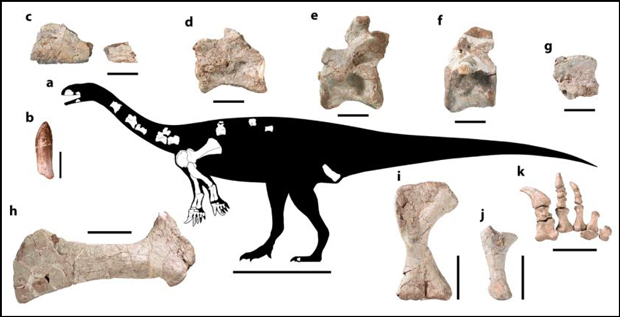Irisosaurus yimenensis – New Species of “Core Prosauropod” from Southern China
Researchers writing in the open access journal Scientific Reports have described a new species of Early Jurassic herbivorous dinosaur from China. The animal, named Irisosaurus yimenensis is known from fragmentary remains and demonstrates a suite of unusual anatomical features that suggests this genus is a member of the Sauropodiformes, between early-branching “core prosauropods” and the late-branching “sauropod-like” members of the non sauropodan sauropodomorphs. The fossilised remains come from the Fengjiahe Formation close to the village of Zhanmatian in Yunnan province.
A Life Reconstruction of Irisosaurus yimenensis

Picture credit: Ang Li
Fossil Material Found in 2018
The researchers which include Claire Peyre de Fabrègues of Yunnan University analysed the partial skeleton and concluded that Irisosaurus has a body plan close to that of the so-called “core prosauropods” in having, for instance, cervical vertebrae longer than most dorsal vertebrae, gracile forelimbs which are much shorter than the hindlimbs, a deltopectoral crest extending half of the total length of the humerus and a unique carpal-metacarpal complex. The fossil material has been dated to approximately 185 million years ago (Pliensbachian faunal stage of the Early Jurassic), it was discovered in 2018. A phylogenetic analysis confirmed that Irisosaurus belongs to non-sauropodan sauropodomorphs and places it as the sister taxon to Mussasaurus which lived more than thirty million years early in Argentina.
Phylogenetic Analysis places Irisosaurus as the Sister Taxon to the South American Mussaurus
Picture credit: Scientific Reports
On the Road to the Sauropoda
The Sauropodomorpha is defined as saurischian dinosaurs that incorporate the Sauropoda and the early diverging sauropodomorphs. The earliest sauropodomorphs are known from the Late Triassic, with most of the described species from Gondwana. The Laurasian record of these types of dinosaurs does consist of some Triassic forms, but the majority of the known species date from the Jurassic. Among the fourteen Jurassic non-sauropodan sauropodomorphs from Laurasia described to date, eight are from China. Nearly all of the non-sauropodan sauropodomorph genera currently known from China were first reported from the Lufeng Formation, which is also associated with the Yunnan province. The Fengjiahe Formation is the southern equivalent of the Lufeng Formation, it has revealed a similar ancient dinosaur dominated biota.
Silhouette of Irisosaurus yimenensis with Some of the Fossil Material

Picture credit: Scientific Reports
What’s in a Name (Etymology)?
The generic name refers to the famous iridescent clouds of Yunnan Province (彩云之南). The specific epithet refers to Yimen County, where the type locality is located
The scientific paper: “A new species of early-diverging Sauropodiformes from the Lower Jurassic Fengjiahe Formation of Yunnan Province, China” by Claire Peyre de Fabrègues, Shundong Bi, Hongqing Li, Gang Li, Lei Yang and Xing Xu published in Scientific Reports.
The Everything Dinosaur website: Everything Dinosaur.







Leave A Comment